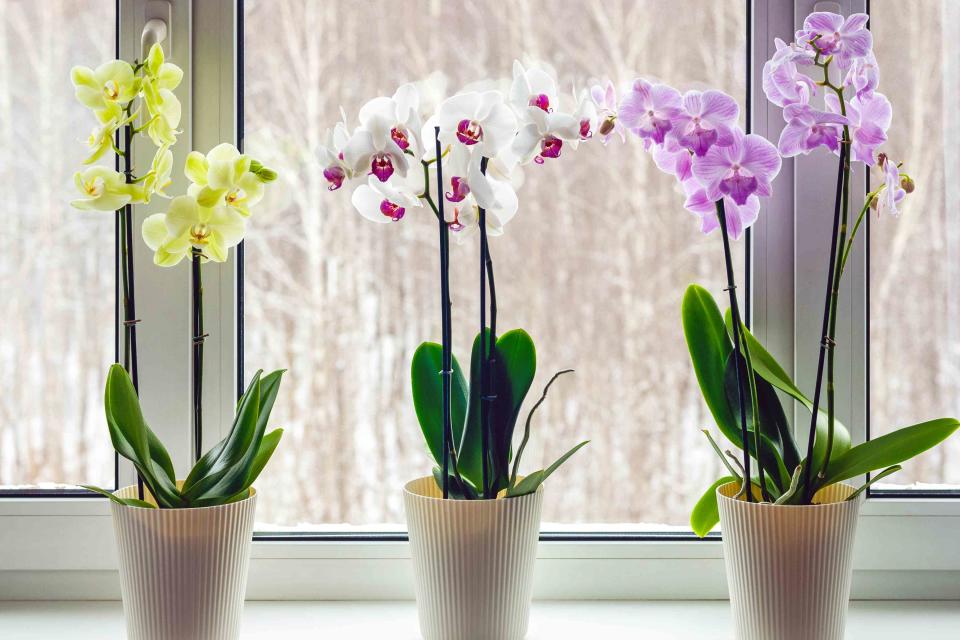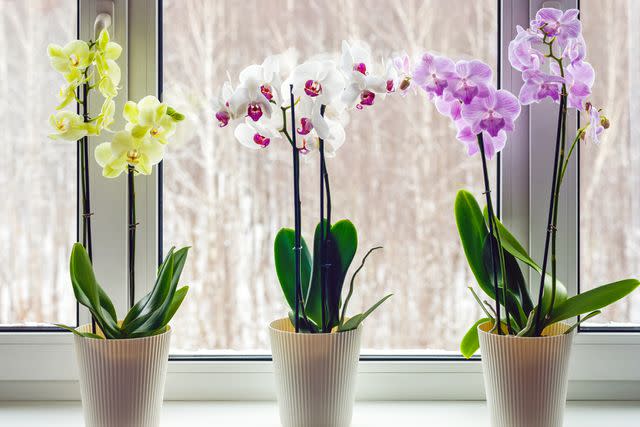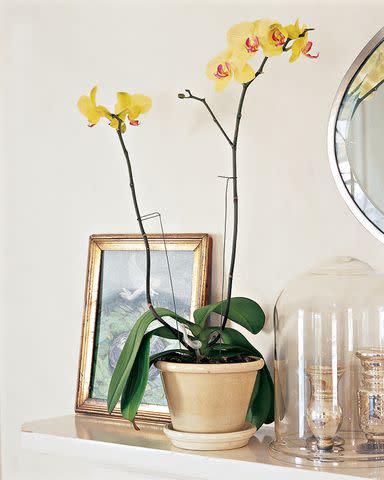How to Prune Your Orchid the Right Way—Plus, When to Do It

The flowering plants thrive with the right care.

Nadya So / GETTY IMAGES
It may seem intimidating to prune your orchid, but it's important to your plant's health: Pruning allows you to control an orchid's growth, removed diseased leaves, and get it ready for repotting. But while many other plant varieties respond well to aggressive cutting, the approach you want to take with an orchid is more of a trim than a hard prune.
"Orchids have a growth form different than other plants that produce multiple branches and stems with many growing points," says Marc Hachadourian, the director of Glasshouse Horticulture and senior curator of orchids at the New York Botanical Garden. "When it comes to orchids, the practice of 'pruning' is approached differently, and in most cases, not at all; in general, orchids are not pruned or trimmed like other plants."
If you do need to rein in unruly growth—perhaps you want to trim back an orchid to fit its spot on your desk, remove leaves, or repot your plant—follow these guidelines for how and when to prune an orchid.
Related: 10 Fascinating Plants That Look Like Animals
Sterilize Your Shears
Before making any cuts to your plant, start with sterilized pruning shears or scissors. "Sterilization is required because orchids can get viruses and diseases from cuts with dirty blades," says Bruce Rogers, orchid expert and author of The Orchid Whisperer, Expert Secrets for Growing Beautiful Orchids.
To sterilize your shears, heat the blades over a gas stove or with a lighter for several seconds, says Rogers (just be very careful with your fingers).

Nadya So / GETTY IMAGES
Monopodial vs. Sympodial Orchids
In general, orchids fall into one of two categories, says Hachadourian. A monopodial orchid has a single stem and root system; common examples are phalaenopsis and vanda. "A monopodial orchid has one growth point, which produces new leaves on top of the old, usually growing upwards from the base where roots emerge," says Hachadourian.
Sympodial orchids, like cattleya, oncidium, and dendrobium, have more than one root system. "A sympodial orchid has a single stem that usually grows horizontally, which can branch and form multiple growth points, often with pseudobulbs," says Hachadourian. "Roots are produced along the stem, with a concentration near the base of the pseudobulb."
How to Trim Monopodial Orchids
If your monopodial orchid is overgrown or has started to shoot out more roots from its stem, you can remove cuttings from the top. "This top growth can be separated with some of its own roots to manage the height of the plant and propagate it," says Hachadourian. "The smaller sections can be potted up and treated like adult plants."
While the orchid will typically bounce back, this type of trimming doesn't need to be a regular part of your maintenance routine. "If there are still strong leaves and roots on the base of the plant, it will often make new shoots and continue to grow," says Hachadourian. "This should only really be done in extreme cases where a plant's growth has become unruly or too tall for the space."
How to Divide Sympodial Orchids
Sympodial orchids, with their multiple root systems, can be divided to propagate the plant or to inspire it to produce new growth—and additional blooms. "Some growers section the rhizome to hopefully stimulate additional new side growths on a plant, encouraging it to grow in multiple directions," says Hachadourian. "It is best to not make divisions smaller than two or three bulbs per section."

How to Extend an Orchid's Flowering Period With Pruning
Phalaenopsis, oncidium, and dendrobium orchids, some of the most common varieties people own, can be trimmed to extend their flowering periods, says Rogers. When you spot the last flower on these varieties ready to die, "count down three nodes—the bumps on the spike where the individual flowers emerge—and use sterilized scissors to cut the end of the flower spike completely off," Rogers instructs. "This will encourage new branches of flowers to emerge from the lower nodes of the spike," which should begin to flower within a few months. "Using this method, it is not uncommon for phalaenopsis, oncidium, and dendrobium orchids to carry flowers for more than a year," Rogers says.
How to Prune an Orchid to Remove Rotten or Diseased Leaves
Orchids that have developed black or brown rotten spots on their leaves should be pruned, says Rogers. "It is best to remove them, because these conditions can spread and eventually kill your orchid," he says.
Using sterilized scissors, cut out any rotten and discolored spots you see. "If they are not removed, it is hard to remember how big and how many there are, and hard to determine if they are spreading."
How to Prune Your Orchid Before Repotting
When orchids are thriving, they will eventually outgrow their original pots and need to be repotted—and when they do, they'll need to be pruned.
After lifting the orchid from the pot, remove all moss or bark from its roots, Rogers says.
Examine the cleaned roots carefully: Roots that are dead will appear just that—with only a thread-like string, with no root material around it. Live roots, on the other hand, will be thick and green or white.
"Cut all the dead roots off clear to where they emerge from the plant," Rogers says. "Cut off all the dead leaves and bulbs and canes."
Then, you can repot it with clean bark or moss.
"When repotting sympodial orchids, older, leafless bulbs can be divided and removed, concentrating the plant's energy on the strongest and newest growth," says Hachadourian. "This is one way to reduce the size of an orchid plant that has grown too much and needs to be reduced in size."
When to Prune Your Orchid
Orchids don't all follow the same growing calendar—and they don't always bloom based on the season. If you need to trim, repot, or divide your plant, the best time is "when the plants have begun active root and new growth," says Hachadourian. "Do not divide or trim plants before or during flowering as it can shorten the life of the blooms and set the plant back for its growth for the season."
To determine the best time to trim your orchid, keep track of its growth. "The best way to determine this is through observing and learning about your plants, since, depending on the type and variety of orchid, the perfect time can vary throughout the year," says Hachadourian. "Pay close attention and look for signs of new leaves and roots to know when the right time of year is to repot and divide your plants."